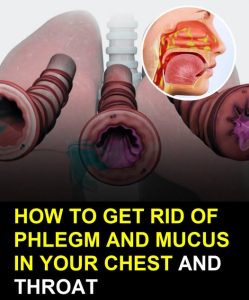Phlegm – it might sound a bit unpleasant, but this slimy substance plays a crucial role in defending your body. Believe it or not, your body produces enough phlegm each day to fill half a two-liter soda bottle. While phlegm is essential for trapping irritants like dust, bacteria, and allergens, too much of it can be uncomfortable and bothersome. Fortunately, there are several effective ways to reduce excess mucus and support better respiratory health.

Phlegm is a type of mucus produced by your respiratory tract. Compared to the mucus found in your nose, phlegm is thicker and stickier, specifically designed to trap harmful particles and keep them from entering your lungs. According to the Cleveland Clinic, phlegm is naturally produced by the body and plays a key role in combating inflammation. Laryngologist Paul C. Bryson explains that while the exact amount of phlegm your body produces daily is unknown, most experts estimate it to be around one liter—enough to fill half a two-liter soda bottle. Typically, when you’re healthy, phlegm works quietly and efficiently without drawing much attention. However, when you’re sick, your body ramps up production, making phlegm thicker and more noticeable as it works harder to trap and expel irritants.
If you’re dealing with excessive phlegm, there are several proven methods to reduce mucus buildup and help you breathe easier. Staying hydrated is one of the simplest yet most effective ways to thin out mucus. Drinking plenty of fluids, such as water, herbal teas, or clear broths, helps loosen phlegm, making it easier to expel from your throat and chest. Dr. Bryson suggests using a simple rule of thumb: drink enough water to keep your urine pale, which indicates proper hydration. Staying well-hydrated helps thin mucus, making it less sticky and easier to clear, while also supporting overall circulation and respiratory function.
Steam therapy is another natural and effective method for reducing phlegm. Inhaling steam helps moisten dry nasal passages and loosen stubborn mucus, allowing it to move more freely. To try steam therapy, boil water and pour it into a bowl. For added benefits, add a few drops of eucalyptus or peppermint oil, which have natural decongestant properties. Cover your head with a towel and inhale deeply for about 10 minutes. If you’re short on time, taking a hot shower can also help open your airways and loosen mucus.
Gargling with salt water is a time-tested remedy that can help break down mucus and relieve throat discomfort. To do this, dissolve half a teaspoon of salt in a glass of warm water and gargle for 30 seconds, making sure the solution reaches the back of your throat. Spit out the solution and repeat several times a day. Salt water helps reduce inflammation in the throat and loosen thick mucus, making it easier to clear.
For quick relief, over-the-counter remedies such as decongestants and expectorants can be helpful. Decongestants work by shrinking swollen nasal tissues, making it easier to breathe, while expectorants like guaifenesin help break down thick mucus so it can be expelled more easily. However, it’s important to consult a healthcare professional before using these medications, especially if you have underlying health conditions.
Herbal remedies have been used for centuries to support respiratory health and reduce mucus buildup. Herbs such as thyme, eucalyptus, and marshmallow root can help soothe inflamed airways and promote mucus clearance. Using eucalyptus balm or essential oil in a diffuser can help loosen chest congestion, while drinking thyme tea made from fresh or dried thyme can provide additional respiratory benefits. Licorice root lozenges are also effective for soothing the throat and reducing irritation.
Using a cool mist humidifier can help maintain moisture in the air, which is essential for keeping your throat and nasal passages hydrated. Dry air can cause mucus to become thicker and stickier, leading to increased congestion. By adding moisture to the air, a humidifier helps reduce mucus production and makes it easier to breathe. Be sure to clean your humidifier regularly according to the manufacturer’s instructions to prevent the growth of mold and bacteria.
Flushing out irritants from your nasal passages can provide quick relief from congestion. Nasal irrigation devices like neti pots or saline sprays are simple and effective tools for clearing out mucus, allergens, and other irritants. Using a saline solution helps thin mucus and flush it out of the nasal passages, reducing congestion and improving breathing. Nasal irrigation is particularly helpful if phlegm has become thick and sticky due to dry air or dehydration.
Keeping your environment clean and free of allergens is essential for minimizing phlegm buildup. Dust, pet dander, and other airborne irritants can trigger mucus production, so maintaining a clean living space can help reduce respiratory symptoms. Make sure to clean or replace the filters in your heating and cooling systems regularly, vacuum carpets and upholstery to remove dust and pet hair, and use an air purifier to reduce airborne irritants. Washing bed linens weekly in hot water can also help eliminate allergens that can contribute to congestion.
While phlegm might not be the most pleasant topic of conversation, understanding its role in your body’s defense system can help you appreciate its importance. From trapping harmful particles to signaling potential health issues, phlegm is more than just a nuisance—it’s a key player in keeping your respiratory system healthy. The good news is that by staying hydrated, using steam therapy, gargling with salt water, and maintaining a clean environment, you can reduce excess phlegm and breathe easier. So the next time you feel congested, try these simple and effective methods to support your respiratory health and get back to feeling your best.
Did you know that phlegm plays such a vital role in keeping your body healthy? We’d love to hear your thoughts!





